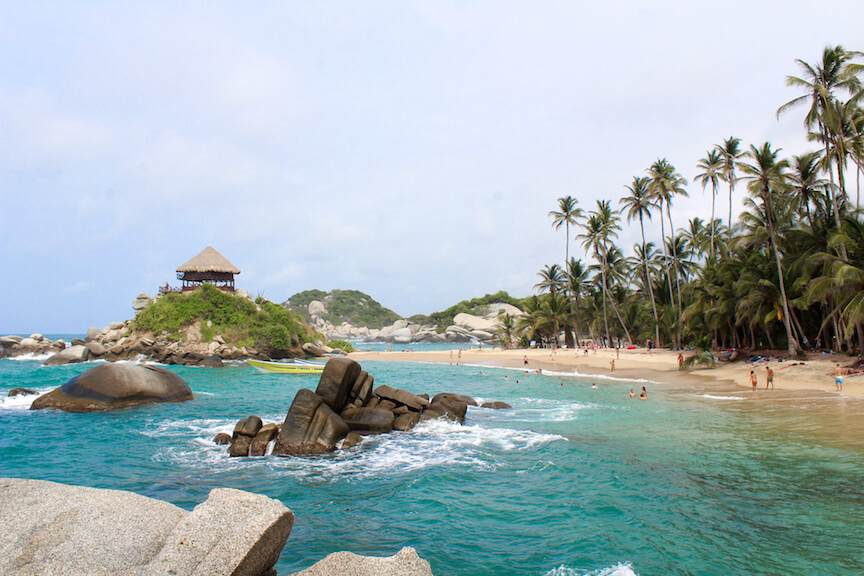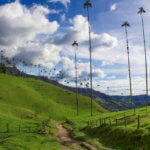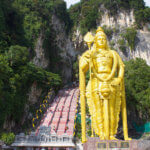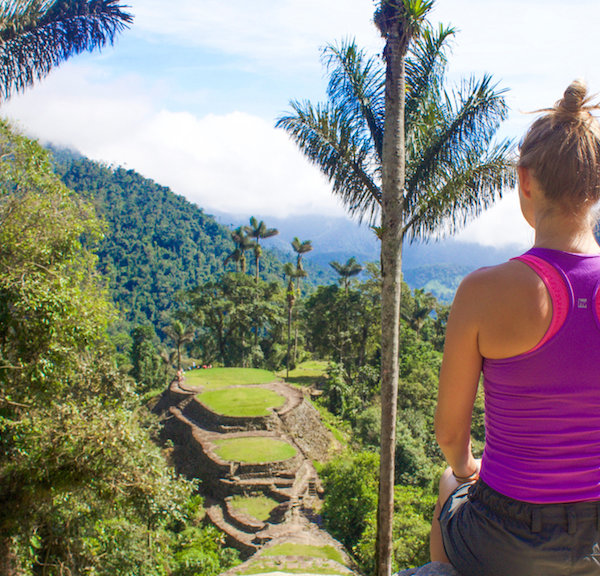Parque Tayrona is a nationally protected park in Northern Colombia sandwiched between the Sierra Nevada de Santa Marta Mountains and the Carribean Sea. It’s known for its lush jungle and wild coastline of virtually untouched beaches. Although many of the beaches between the park entrance and Cabo San Juan are frequented by tourists, they are only accessible by foot in order to keep this part of the country preserved. After two days and a few mistakes along the way, I’ve created this post to share what I’ve learned to help you better plan your trip to Parque Tayrona!
1. Give yourself enough time to get to Parque Tayrona

Trust me, I learned the hard way! My flight was delayed so I was a few hours behind schedule and then I realized that it takes much longer to get to Parque Tayrona from Santa Marta than I had anticipated. It’s Colombia, there’s always traffic! By the time I arrived in Santa Marta (which is the airport you would fly into if coming from somewhere else in the country), it was much too late and I ended up having to book a night in the city and had to wait for the following morning to head to the park. Parque Tayrona closes at 5 pm and you certainly don’t want to be hiking in the dark. You can take a bus from Santa Marta to the park entrance for about 7,000 COP ($2.50 USD) or an Uber if you’re in the mood for a private ride for about 58,000 COP ($20 USD). To be safe, I’d spend a night in Santa Marta and then wake up super early the next day and make your way towards the park.
2. Don’t waste your money on a room

If I was to go back to Parque Tayrona I would 100% sleep in a hammock. I booked an extremely overpriced room at Castilletes and it was a dump. For what they charge, it is incredible how bare bones this accommodation is, and honestly, I would avoid it at all costs. Save your money and rough it – it’s a better experience anyways!

I would recommend staying in a hammock at Cabo San Juan. There are tents you can rent on the piece of land behind the beach, but it looks like a better, more peaceful experience to stay in the hammocks located on the famous elevated terrace overlooking the ocean. These hammocks don’t have mosquito nets because the ocean breeze keeps the bugs away! Renting these hammocks for the night will only set you back about 20,000 COP ($7 USD) per night. They are typically in high demand so the earlier you arrive to reserve your space, the better!
If you’re not much of a camper and sleeping in a hammock doesn’t sound appealing to you (and you have plenty of money to spend) you could always stay in the uber-luxurious Eco-Habs. If you do end up staying here, please drop me a comment and make me super jealous!
3. Pack super light or hire a horse to take your things

The hike to Cabo San Juan is much hotter and tougher than I presumed. Luckily, I only had a light daypack with me, so it wasn’t too bad, but I saw a few groups hiking with full on 65L packs and they looked like they were about to croak. If you have more than a light daypack, definitely hire a horse to carry your stuff. The cost is 40,000 COP ($13.50 USD) and is very worth it! If you’re only going to Cabo San Juan for a day trip (which I wouldn’t recommend – it’s worth staying overnight!) I would also recommend riding a horse back to the main entrance in order to save time and spend more of your day at the beach instead of doing the same 2.5 hour hike back. You can reserve a horse with the guys at the entrance of Cabo San Juan by leaving a 50% deposit and they will guarantee you a ride back. The last horse returning to the entrance of Parque Tayrona leaves Cabo San Juan at 4:30 pm. I must warn you, it was a bit nerve-wracking, as the horses were slipping on really steep inclines/declines, but we did arrive back to the Eco-Habs parking lot in one piece, so I won’t complain. It’s all part of the adventure anyways! If possible, I’d even recommend leaving your luggage at a hotel in Santa Marta and just taking a light daypack with you to avoid having to pay for horses if you’re on a budget!
4. Spend a minimum of 2-3 days exploring Parque Tayrona

With beaches like Castilletes, La Piscina, Cabo San Juan, and Playa Brava (to name a few), as well as the Pueblito hike, it would be a shame not to give yourself enough time to really explore the park. Beyond Cabo San Juan is Playa Brava, which I didn’t make it to, but heard it was really stunning. Since Cabo San Juan is the main destination for hikers, you’ll most likely have the majority of Playa Brava to yourself. My fellow blogger friend, Thomas, wrote a great post about Playa Brava, Pueblito and some other places in Parque Tayrona that I didn’t have time to get to, and would recommend checking it out!!!

The hike from where the shuttle drops you off to Cabo San Juan is about 3 hours (if you stop for regular water breaks which you should!) and that’s without stopping at all of the beaches along the way. I only stayed here for two nights and it simply wasn’t enough time to see all that there is to see in this beautiful park. If you have the time, and you’re okay with the hammock/camping life, I would recommend at least 3 nights to truly see all that this park has to offer.
5. Take the “no swimming” precautionary signs seriously

There is an extremely strong current along the entire coast of Parque Tayrona and many people have died here trying to swim. In addition, there are no lifeguards, surfers, or rescue teams, so if you get sucked out to sea, no one is there to save you. Don’t try to be invincible, respect the signs and stay safe! I didn’t even go up to my waist and the current was pulling me super hard. Be careful!
6. Bring your own food

Food inside the park is quite expensive for Colombian standards. I would recommend bringing some non-perishable items like bread, tuna, nuts, peanut butter, jelly, fruit and other snacks to hold you over. There’s a little stand at Cabo San Juan selling some snacky things as well as Gatorade and water, but it may just be better to bring what you like. There’s at least one place to buy a meal at each of the main beaches, so don’t worry too much if you don’t have time to stock up on food before you go.
7. Try to get to the Parque Tayrona entrance as early as possible

They technically open at 8 am, but we arrived by 8:30 am and the line to register our passports took well over an hour! Keep in mind that no one is allowed to enter the park without registering each and every passport in your group. Apparently, you’re also required to watch a safety video about how to protect the park, but some reason we were not stopped to watch it. If you arrive super early, not only will you beat the massive line that tends to accumulate each and every day, but you will also beat the mid-morning/afternoon sun that is super strong. If you beat the line, of course, that means that you probably will have the trail to yourself, and how nice is that!
8. Utilize the shuttle from the park entrance
For 3,000 COP ($1 USD) you can hop on a shuttle from the park entrance that will drop you off at the parking lot at the very ritzy Eco-Habs. This is where the trail along the coast towards Cabo San Juan technically starts. The ride is only about 10 minutes but will save you 1 hour of unnecessary hiking. The hike to Cabo San Juan from where the bus drops you off is about 2.5-3 hours as it is, so why walk along a boring paved road when you can grab a bus for a buck?
9. Stay hydrated & rest often

Even if you’re a very experienced hiker or you’re in great shape, the heat during this strenuous hike is no joke! Heat stroke is common, and keep in mind that you’re in the middle of the jungle with little to no access to medical attention. (There is one first aid tent located in Arrecifes if you are desperate.) Make sure you take the time to stop and drink plenty of water and rest. Although I recommend bringing a reusable water bottle with you, don’t worry too much about running out because there are many people selling water, Gatorade, and popsicles along the trail to keep you hydrated.
Wander On,
Wanderluluu xx










6 comments
Edgar
Hey, I have some questions I am going to Tayrona with my family in August but we will be going by car since we are going to stay in Cartagena first. So we personally all have our huge luggage bags since we are coming from the States. What would you recommend us doing with the luggage bags and the rental car? Thanks for your help
Lauren Mae Pelkey
Hi Edgar! I just reached out to a hostel nearby that may allow you to park and store your bags! I will get back to you as soon I hear anything.
Nati
Where exactly is the camping site where you saw the hammocks? I see a lot of camping sites in and around Cabo San Juan but can’t figure out which! Thanks!
Lauren Mae Pelkey
Hey Nati! It’s literally up on a hill/rock right on the beach!! There is a little hut and the hammocks are right underneath it
hema khan
Wow, you have beautifully decorated this post. I really appreciate it very much. People like you also exist in the world. Who share everything. And there are some people who do not share anything with anyone. I wish today’s youth wrote your kind post, thank you very much.
Lauren Mae Pelkey
Thank you for your kind words! Happy Travels!